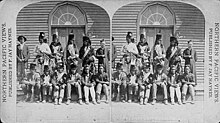
Back Reserva índia de Red Lake Catalan Indiana Rezervejo Ruĝa Lago Esperanto Réserve indienne de Red Lake French Miskwagamiwisagaigan Croatian Ред-Лейк (индейская резервация) Russian Miskwagamiwisagaigan Serbo-Croatian
Red Lake Indian Reservation | |
|---|---|
 Red Lake welcome sign in Bejou, Minnesota in 2023 | |
 Location in Minnesota | |
| Country | United States |
| Tribe | Red Lake Band of Chippewa |
| State | Minnesota |
| Counties | Beltrami Clearwater |
| Headquarters | Red Lake |
| Government | |
| • Body | Tribal Council |
| • Chairman | Darrell G. Seki, Sr. |
| • Secretary | Sam Strong |
| • Treasurer | Vernelle R. Lussier |
| Area | |
| • Total | 1,260.32 sq mi (3,264.2 km2) |
| • Land | 883.087 sq mi (2,287.18 km2) |
| • Water | 377.233 sq mi (977.03 km2) 29.9% |
| Population (2020)[3] | |
| • Total | 5,506 |
| • Density | 6.2/sq mi (2.4/km2) |
| Website | redlakenation.org |












The Red Lake Indian Reservation (Ojibwe: Miskwaagamiiwi-zaaga'iganing) covers 1,260.3 sq mi (3,264 km2; 806,600 acres)[2] in parts of nine counties in Minnesota, United States. It is made up of numerous holdings but the largest section is an area around Red Lake, in north-central Minnesota, the largest lake in the state. This section lies primarily in the counties of Beltrami and Clearwater. Land in seven other counties is also part of the reservation. The reservation population was 5,506 in the 2020 census.[3]
The second-largest section (49°16′N 95°03′W / 49.267°N 95.050°W) is much farther north, in the Northwest Angle of Lake of the Woods County near the Canada–United States border. It has no permanent residents. Between these two largest sections are hundreds of mostly small, non-contiguous reservation exclaves in the counties of Beltrami, Clearwater, Lake of the Woods, Koochiching, Roseau, Pennington, Marshall, Red Lake, and Polk. Home to the federally recognized Red Lake Band of Chippewa, it is unique as the only "closed reservation" in Minnesota. In a closed reservation, all land is held in common by the tribe and there is no private property.[4]
The tribe claims the land by right of conquest and aboriginal title; they were not reassigned to it by the United States government.[4] The Red Lake Band of Chippewa refused to join with six other bands in organizing as the Minnesota Chippewa Tribe in the mid-1930s; at the time, its people wanted to preserve their traditional system of hereditary chiefs, rather than forming an electoral government. As of 2011, the Ojibwe language is the official language of Red Lake.[5] Seven principal clans (doodems) found on the Red Lake Indian Reservation are makwa (bear), mikinaak (turtle), owaazisii (bullhead), nigig (otter), migizi (eagle), waabizheshi (marten), and ogiishkimanisii (kingfisher). As a population minority name (sturgeon) and adik (caribou) clans are also found.[6]
In the 2000 census, Red Lake was the most populous reservation in the state, with 5,162 residents. The only place in Minnesota with a higher Native American population at that time was the state's largest city, Minneapolis, 250 miles to the south; it recorded 8,378 Indian residents that year. By 2007, the White Earth and Leech Lake reservations (both led by parts of the Minnesota Chippewa Tribe) had higher resident populations of enrolled Ojibwe. The reservation's largest community is Red Lake, on the south shore of Red Lake. Given the large lake in the heart of the reservation, its total land area of 883.08 square miles (2,287.2 km2) covers about 70% of the reservation's surface area.[2]
- ^ "Tribal Council Members". Retrieved 2019-07-24.
- ^ a b c Cite error: The named reference
gaz2020was invoked but never defined (see the help page). - ^ a b Cite error: The named reference
2020-census-3100was invoked but never defined (see the help page). - ^ a b Charles Brill (1992). Red Lake Nation: Portraits of Ojibway Life, University of Minnesota Press, p. 19. ISBN 0-8166-1906-9
- ^ Meurs, Michael (2011-09-21). "Native American Language Revitalization on Red Lake Agenda". Indian Country Today Media Network. Archived from the original on 2013-06-29. Retrieved 2013-04-13.
- ^ Treuer, Anton (2011). The Assassination of Hole in the Day. Borealis Books. ISBN 978-0873518017.
© MMXXIII Rich X Search. We shall prevail. All rights reserved. Rich X Search
